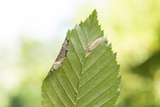Parornix carpinella (Frey, 1863) Species
Last modified: Dec. 14, 2024, 3:05 p.m.
A local and rare species throughout Belgium, though widespread.
Details
- Classification
- Family: Gracillariidae > Subfamily: Gracillariinae > Tribus: Parornichini > Genus: Parornix > Species: Parornix carpinella
- Vernacular names
- Haagbeukzebramot (NL), Hornbeam slender (EN), Hainbuchen-Randfaltenmotte (DE)
- First mention in Belgium
- De Crombrugghe G. 1898. Note sur quelques Lépidoptères nouveaux pour la faune belge. — Annales de la Société Entomologique de Belgique 42: 34–38. On page 36 (as Ornix Carpinella Frey). view page
- Status
-
Native
Distribution
Imago
The forewing ground colour is greyish with many small, inconspicuous, whitish striae along the costa; and some brown spots near the inner margin. Identification is difficult without knowledge of the larval hostplant, because of the close resemblance with other Parornix species, without the study of its genitalia.
Museum specimens
No pictures yet!Specimens in nature
No pictures yet!Caterpillar
Greenish yellow to green with light brown head capsule; a row of four dark brown spots on the thoracic plates, the two inner ones clearly larger than the two outer ones.
Mine
At first starting with a small blotch, most often in a vein axil on the underside of a leaf. Silk is applied in the mine but does not contort it leaving the mine flat. The blackish frass is contained in the basal corner of the mine which at the opposite side ends with two square angles.
See also gracillariidae.net and bladmineerders.be.
Bionomics
During the free-living stages, the caterpillar folds a leaf margin downwards and feeds under the fold. It never makes a leaf roll as in some other Parornix species.
Pupation within the leaf fold, among leaf litter on the ground. The species hibernates in the pupal stage
The adults rest during the daytime in the foliage; they are active at dusk and during the night and come to light.
Flight periods
The adults fly in two generations a year in May and again in July–August.
Observed on
- Host plant (species):
- Carpinus betulus
The larvae feed exclusively on Carpinus betulus.

